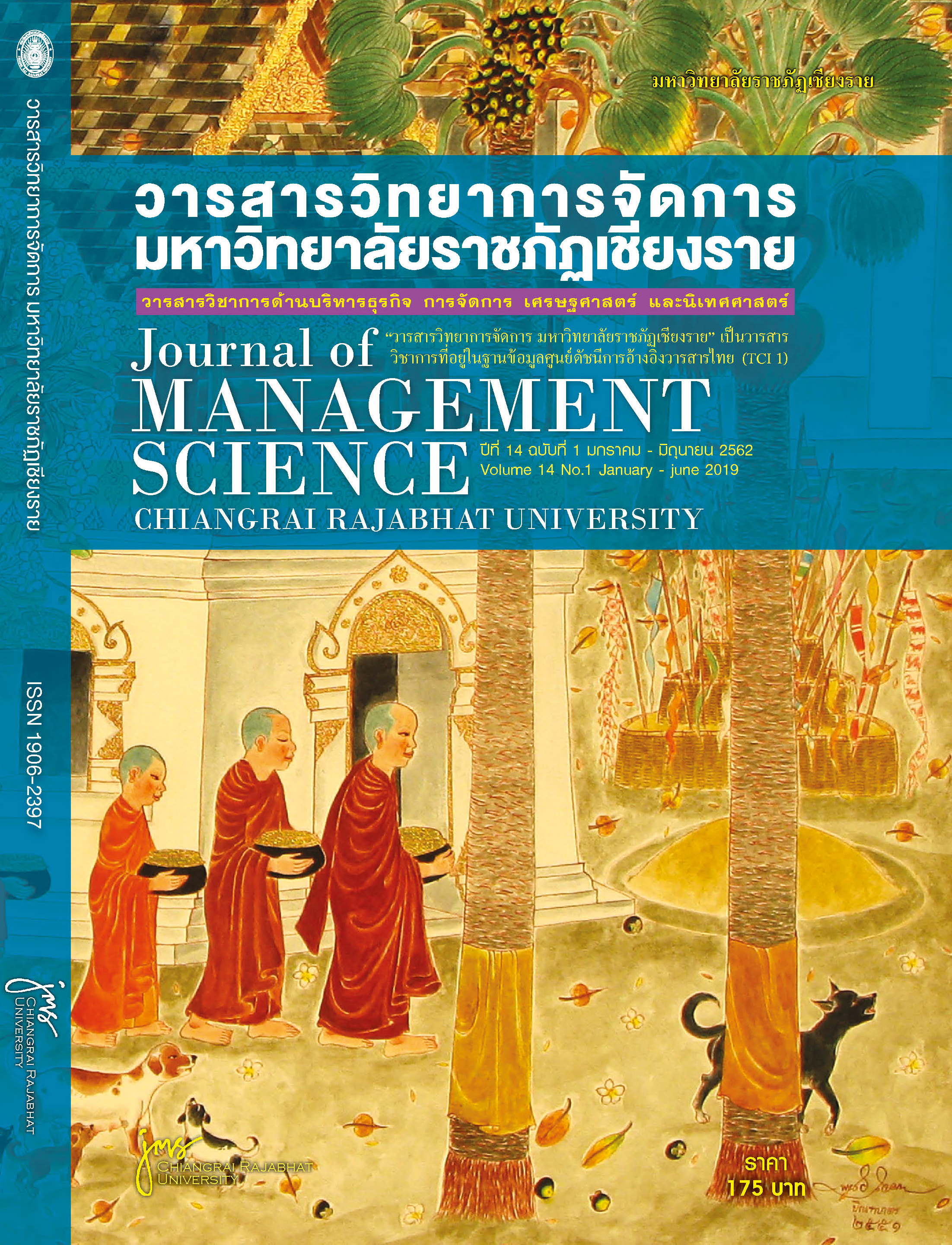The Relationship between Risk Management Disclosures and Earnings Management: A Case Study of Listed Companies in the Stock Exchange of Thailand
Main Article Content
Abstract
This study’s objectives are to investigate the risk management disclosures and to test the relationship between the risk management disclosures and earnings management. By quota and simple random sampling, sample is 235 listed companies in the Stock Exchange of Thailand. The risk management disclosures and earnings management are collected from either annual reports or 56-1 reports in 2015. Descriptive analysis and multiple regression are used to analysis the data. As the results, the average level of risk management disclosures of listed companies is in good level. The most common disclosures of risk management are corporate internal environment and monitoring categories, while the category of event identification is the less common disclosure. To test the relationship between the level of risk management disclosures and earning management, this study finds that risk response and size of company have negative correlation with earnings management.
Article Details
Views and opinions expressed in the journal do not necessarily reflect those of the editors.
References
Argenti, P. (2003). Corporate communication, 3 Edition. New York: The McGraw – Hill Companies
Artayapan, P. (2007). The effects of risk management efficiency on the performance of small and medium enterprises in Bangkok. Master Degree Thesis in Management, Mahasarakham University. (in Thai)
Ayres, F., (1994). Perceptions of Earnings Quality: What Managers Need to Know. Management Accounting. 75, 27-29.
Barton, J. & Simko, P. (2002). The balance sheet as an earnings management constraint. Accounting Review. 77(Supplement), 1-27.
Beasley, M., Clune, R., & Hermanson, D. R. (2005). Enterprise risk management: An empirical analysis of factors associated with the extent of implementation. Journal of Accounting and Public Policy. 24(6), 521-531.
Beasley, M., Pagach, D., & Warr, R. (2008): Information Conveyed in Hiring Announcements of Senior Executives Overseeing Enterprise-Wide Risk Management. Journal of Accounting, Auditing and Finance. 23(3), 311-332.
Becker, C.L., Defond, M.L., Jiambalvo, J., & Subramanyam, K.R. (1998). The effect of audit quality on earnings management. Contemporary Accounting Research. 15, 1-24.
Damrongsukniwat, P. & Issarawornrawanich, P. (2013). The relationship between firm size and earnings management: empirical evidence from firms under the property development sector in the Stock Exchange of Thailand (SET). Journal of Accounting Profession. 9(26), 61-73. (in Thai)
DeFond, M.L. & Jiambalvo, J. (1991). Incidence and Circumstances of Accounting Errors. The Accounting Review. 66(3), 643-655.
Degeorge, F., Patel, J., & Zeckhauser, R. (1999). Earnings management to exceed thresholds. The Journal of Business. 72, 1-33.
Hinkle, D.E, William, W., & Stephen G. J. (1998). Applied Statistics for the Behavior Sciences. 4thed. New York: Houghton Mifflin
Homtragoon, S. (2012). Disclosures on COSO Enterprise Risk Management Framework of the Listed Companies in the Stock Exchange of Thailand in SET 100. Master Degree Thesis in Business Administration, Kasetsart University. (in Thai)
Jensen, M. C. & Meckling, W. H. (1976). Theory of the firm: Managerial behavior, agency costs and ownership structure. Journal of Financial Economics. 3(4), 305-360.
Jones, J. (1991). Earnings management during import relief investigations. Journal of Accounting Research. 29, 193-228.
Kaewprapa, A. (2010). The Relationship between Risk Reporting Quality, Company Size and Industry of the Listed Companies in the Stock Exchange of Thailand. Master Degree Thesis in Business Administration, Kasetsart University. (in Thai)
Kampanartkosol, K. & Tangruenrat, C. (2008). Earnings management and financial leverage. Journal of Accounting Profession. 4(10), 68-78. (in Thai)
Mohd-Ali, S., Hassan, M. S., & Mohd-Saleh, N. (2007). Block ownership and earnings management in Malaysian listed firms. Corporate Ownership and Control. 5(2), 195-201.
Mulford, C. W. & Comiskey, E. E. (1996). The financial numbers game: detecting creative accounting practices. John Wiley & Sons.
Nocco, Brian W. & Rene M. Stulz. (2006). Enterprise Risk Management: Theory and Practice. Journal of Applied Corporate Finance. 18(4), 8-20.
Pallakul, P. & Srijunpetch, S. (2007). How do listed companies use the risk framework under COSO ERM?. Journal of Accounting Profession. 3(7), 73-87. (in Thai)
Patricia M. Dechow, Richard G. Sloan, & Amy P. Sweeney. (1995). Detecting Earnings Management. The Accounting Review. 70(2), 193-225.
Pinijnorachai, J. (2007). Auditor rotation and earnings management via discretionary accruals: evidence from the Stock Exchange of Thailand. Master Degree Thesis in Accounting, Thammasat University. (in Thai)
Siregar, S. V. & Utama, S. (2008). Type of earnings management and the effect of ownership structure, firm size, and corporate-governance practices: Evidence from Indonesia. The international journal of accounting. 43(1), 1-27.
Somjae, C. (2013). A study of earnings management to meet or exceed investor expectation by analysts’ forecast: A case study of listed companies in the stock exchange of Thailand. Master Degree Thesis in Accounting, Burapa University. (in Thai)
Kortana, T. (2017). Factors Influencing to the Success in the Implementation of Good Governance of Public Companies in Thailand. Journal of Management Science Chiangrai Rajabhat University, 12(2), 60-77. (in Thai)
Thai Institute of Directors. (2010). Corporate Governance Report of Thai Listed Companies 2010. Retrieved June 22, 2017, from
https://thai-iod.com/imgUpload/file/CGR2010/2010%20Brochure%20CGR.pdf
The Stock Exchange of Thailand. (2003). ERM Framework. Retrieved June 22, 2017, fromhttps://www.set.or.th/th/about/overview/files/ERM_Framework_2016.pdf
Toommanon, V. (2000). Do you know Creative Accounting and Earnings Quality?. Bangkok: Ionic Inter trade Resources. (in Thai)
White, G.I., Sondhi, A.C., & Fried, D. (1997). The analysis and use of financial statements. 2 Edition. New York: John Wiley.
Wongboonnate, P. (2006). COSO ERM Risk Management to Reduce Risk in Auditing in the Certified Public Accountants' view. Master Degree Thesis in Accounting, Thammasat University. (in Thai)
Wongsawasdiwat, J. (2004). Attitude, Belief, and Behavior: Measurement, Prediction, and Change. 3 Edition. Bangkok: Amarin Printing and Publishing. (in Thai)
Yamane, Taro. (1967). Statistics, an Introductory Analysis. 2 Edition. New York: Harper and Row.
Yang, C. Y., Lai, H. N., & Leing, T. B. (2008). Managerial ownership structure and earnings management. Journal of Financial Reporting and Accounting. 6(1), 35-53.


